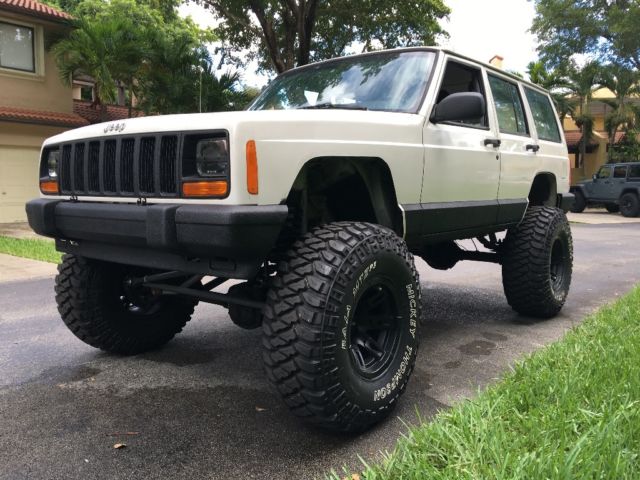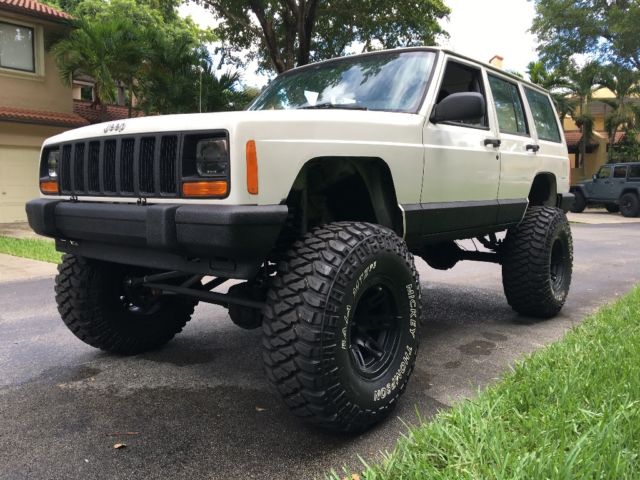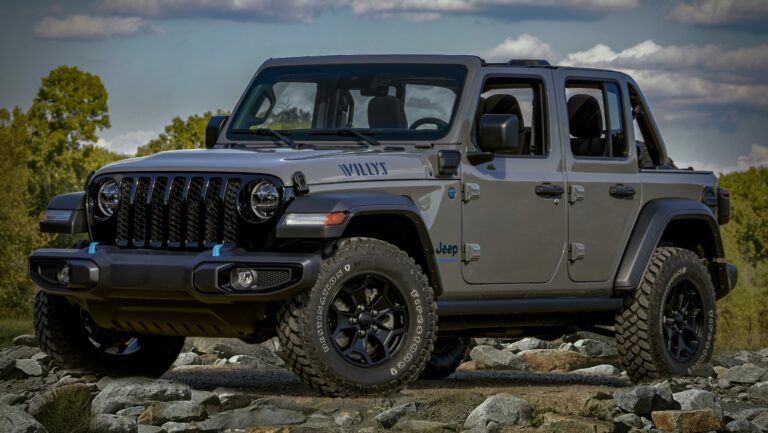1997 Jeep XJ For Sale: Your Ultimate Guide to Finding and Owning a Legend
1997 Jeep XJ For Sale: Your Ultimate Guide to Finding and Owning a Legend jeeps.truckstrend.com
The automotive landscape is constantly evolving, yet some vehicles transcend time, earning a permanent place in the hearts of enthusiasts and practical drivers alike. Among these enduring icons, the Jeep Cherokee XJ stands tall, a testament to rugged simplicity and unparalleled capability. And within the XJ’s storied production run, the 1997 Jeep XJ For Sale often represents a sweet spot, combining the model’s legendary durability with a welcomed interior refresh and subtle exterior updates.
For anyone searching for a versatile SUV that can tackle daily commutes, conquer challenging trails, or serve as a reliable project vehicle, a 1997 Jeep XJ offers an compelling proposition. It’s not just a car; it’s a lifestyle, a canvas for customization, and a gateway to a vibrant community. This comprehensive guide will delve into everything you need to know about finding, evaluating, and owning a 1997 Jeep XJ, ensuring you make an informed and satisfying purchase.
1997 Jeep XJ For Sale: Your Ultimate Guide to Finding and Owning a Legend
Why the 1997 Jeep XJ Stands Out: A Blend of Old and New
The Jeep Cherokee XJ, produced from 1984 to 2001, is celebrated for its unibody construction, which blended SUV utility with car-like handling, a revolutionary concept at the time. The 1997 model year holds particular significance due to its mid-cycle refresh. While retaining the beloved straight-six engine and solid axles, the ’97 XJ introduced several key improvements that make it highly desirable:
- Refreshed Interior: The most significant change was a completely redesigned dashboard, door panels, and center console. This brought a more modern, ergonomic feel to the cabin, improving comfort and functionality without sacrificing the XJ’s utilitarian charm. New seating designs also enhanced comfort.
- Subtle Exterior Updates: The exterior received minor tweaks, including a redesigned tailgate with a center-mounted license plate, new taillights, and updated body side moldings. These changes gave the XJ a slightly more contemporary look while maintaining its iconic silhouette.
- Proven Powertrain: Beneath the updated skin, the 1997 XJ retained the legendary 4.0-liter "High Output" (HO) inline-six engine. This engine is renowned for its robust torque, incredible longevity, and straightforward design, making it a favorite for both daily driving and off-road abuse. It was typically paired with the reliable Aisin-Warner AW4 automatic transmission, though a five-speed manual (AX-15) was also available, albeit rarer.
- Solid Axle Durability: Unlike many modern SUVs, the XJ utilized solid front (Dana 30) and rear (Dana 35 or the more desirable Chrysler 8.25) axles. This design provides superior articulation and durability for off-road driving, and ample aftermarket support for upgrades.
- Improved NVH (Noise, Vibration, Harshness): Jeep engineers made efforts to reduce cabin noise and vibrations, resulting in a slightly more refined driving experience compared to earlier models.

These refinements make the 1997 XJ a sweet spot – it benefits from the updated interior and exterior without sacrificing the mechanical simplicity and ruggedness that define the XJ generation.
The Undeniable Benefits of Owning a 1997 Jeep XJ
Beyond its historical significance, owning a 1997 Jeep XJ comes with a host of practical advantages:
- Legendary Reliability: The 4.0L engine is often cited as one of the most reliable engines ever produced, capable of racking up hundreds of thousands of miles with proper maintenance.
- Exceptional Off-Road Capability: Even in stock form, the XJ is remarkably capable off-road. Its compact size, short overhangs, and solid axles allow it to navigate tight trails and challenging terrain with ease.
- Ease of Maintenance and Repair: The XJ’s mechanical simplicity means that many repairs can be performed by a moderately skilled DIY enthusiast. Parts are abundant and generally affordable, thanks to its long production run and widespread popularity.
- Vast Aftermarket Support: Whether you want a mild lift, heavy-duty bumpers, lockers, or just replacement parts, the aftermarket for the XJ is immense. This allows for endless customization to suit any need or desire.
- Affordability: Compared to new SUVs with similar capabilities, the 1997 XJ offers incredible value. Its purchase price is typically low, leaving room in the budget for maintenance, upgrades, or personalization.
- Strong Community and Resale Value: The XJ boasts a passionate global community, offering a wealth of knowledge, tips, and camaraderie. Its iconic status also means it holds its value remarkably well, especially well-maintained examples.

A Buyer’s Guide: What to Look For When Buying a 1997 Jeep XJ
Purchasing a vintage vehicle like a 1997 XJ requires a keen eye and a methodical approach. While the XJ is tough, decades of use can take their toll. Here’s a detailed checklist:
-
Rust, Rust, Rust (The XJ’s Arch Nemesis): This is the most critical factor. Check thoroughly for:
- Frame Rails: Especially under the front seats and near the rear leaf spring mounts.
- Rocker Panels: These are notorious rust spots. Look for bubbling paint or holes.
- Floorboards: Lift the carpets, particularly in the front and rear footwells.
- Rear Quarter Panels: Behind the rear wheels.
- Doors: Lower edges and corners.
- Roof Seams: Where the roof meets the side panels.
- Crossmembers and Suspension Mounts: Ensure structural integrity. Surface rust is common and manageable, but rot is a deal-breaker.
-
Engine (4.0L I6):
- Leaks: Check for oil leaks (especially the rear main seal, valve cover gasket – common but not critical unless severe), coolant leaks (from radiator, hoses, water pump).
- Sounds: Listen for knocking, ticking, or excessive lifter noise. A little lifter tick on startup is common, but it should quiet down.
- Cooling System: Inspect the radiator, fan clutch, and hoses. Overheating is an XJ weak point if neglected. Look for milky oil (head gasket) or sweet smell (coolant leak into cabin).
- Exhaust: Check for excessive smoke (blue for oil, white for coolant, black for rich fuel).
-
Transmission (AW4 Automatic/AX-15 Manual):
- Automatic: Smooth shifts, no slipping, no harsh clunks. Check fluid level and color (should be reddish, not brown or burnt).
- Manual: Smooth engagement, no grinding, clutch feel.
-
Transfer Case (NP231 Command-Trac/NP242 Selec-Trac):
- Engage all 4WD modes (2H, 4H, 4L, 4FT if NP242) during a test drive. Listen for unusual noises or binding. Ensure it shifts smoothly.
-
Axles and Drivetrain:
- U-Joints: Check for play in driveshafts and axle shafts.
- Differential Leaks: Look for fluid around the differential covers.
- Gears: Listen for whining or clunking during acceleration/deceleration.
-
Suspension and Steering:
- Shocks and Springs: Check for leaks on shocks, sagging leaf springs (especially in the rear).
- Steering Components: Inspect the track bar, tie rod ends, ball joints, and control arm bushings for wear. Excessive play can lead to the dreaded "death wobble."
-
Interior and Electrical:
- Dashboard: Check for cracks (common, but the ’97 refresh made it more durable).
- Electronics: Test all windows, power locks, radio, HVAC controls, gauges, and lights.
- Seats: Check for tears, stains, and functionality.
-
Documentation and History:
- Ask for maintenance records. A well-documented history is a strong indicator of a cared-for vehicle.
- Run a VIN check for accident history or flood damage.
-
Test Drive: This is non-negotiable. Pay attention to how it drives, handles, brakes, and sounds at various speeds. Listen for unusual noises, feel for vibrations or pulling.
Common Issues and Solutions
Even well-maintained XJs can exhibit common quirks. Knowing these can help you budget for future repairs or negotiate the price:
- Cooling System Weakness: The XJ’s cooling system is adequate but can be marginal, especially in hot climates or during heavy use. Solution: Upgrade to a heavier-duty radiator, replace the water pump, thermostat, fan clutch, and hoses proactively.
- Oil Leaks (Rear Main Seal/Valve Cover): These are extremely common. Solution: While the rear main seal is a bigger job, many owners live with minor leaks. Valve cover gaskets are easy to replace.
- Death Wobble: A violent, uncontrollable shaking of the front end, usually triggered by a bump at speed. Solution: Almost always caused by worn steering or suspension components (track bar, tie rod ends, ball joints, control arm bushings). Diagnosis and replacement of worn parts are key.
- Sagging Rear Leaf Springs: Over time, the rear leaf springs can flatten or sag, reducing ride height and load capacity. Solution: Add-a-leaf kits or full leaf spring replacement.
- Electrical Gremlins: Older wiring can lead to intermittent issues with windows, gauges, or lighting. Solution: Inspect wiring harnesses, clean grounds, and replace faulty components.
- Fuel Pump Issues: The fuel pump often lives under the rear seat and can fail over time. Solution: Easy to diagnose (no fuel pressure) and replace.
Stock vs. Modified XJs: Understanding the Landscape
When searching for a 1997 Jeep XJ For Sale, you’ll encounter a spectrum from bone-stock examples to heavily modified off-road machines.
- Stock XJs: These are often ideal for daily driving, have typically seen less abuse, and provide a blank slate for your own modifications. They might command a slightly higher price if in excellent, original condition.
- Mildly Modified XJs: A small lift (2-3 inches) and slightly larger tires are common and generally well-executed. These offer enhanced capability without significantly compromising daily drivability.
- Heavily Modified XJs: Featuring large lifts, massive tires, custom bumpers, winches, and axle upgrades. While impressive, thoroughly inspect the quality of the modifications. Poorly executed modifications can lead to more problems than they solve, potentially indicating a history of hard off-road use or neglect.
Assess your needs. If you plan serious off-roading, a well-built modified XJ might save you time and money. If you prefer a daily driver with occasional trail use, a stock or mildly modified version might be a better starting point.
Practical Advice and Actionable Insights
- Budget Beyond the Purchase Price: Always set aside funds for immediate maintenance (fluids, filters, spark plugs) and potential repairs.
- Get a Pre-Purchase Inspection (PPI): If possible, have a trusted mechanic (especially one familiar with Jeeps) perform a PPI. It’s a small investment that can save you thousands.
- Don’t Rush: The XJ market is active. Be patient, look at multiple vehicles, and don’t settle for the first one you see.
- Join XJ Forums/Groups: Online communities are invaluable resources for advice, troubleshooting, and even finding vehicles for sale.
- Negotiate: Always be prepared to negotiate, especially if you identify issues during your inspection.
1997 Jeep XJ For Sale: Estimated Price Guide
Pricing for a 1997 Jeep XJ can vary wildly based on condition, mileage, modifications, and regional demand. This table provides a general guideline:
| Condition Category | Mileage Range | Modification Level | Estimated Price Range (USD) | Notes/Description |
|---|---|---|---|---|
| Poor | 200,000+ miles | Any | $1,000 – $3,000 | Significant rust, major mechanical issues, interior damage. Project vehicle only. |
| Fair | 150,000 – 200,000 miles | Stock to Mild | $3,000 – $6,000 | Moderate rust, needs significant maintenance/repairs, cosmetic flaws. Driveable but needs work. |
| Good | 100,000 – 150,000 miles | Stock to Mild | $6,000 – $10,000 | Minor rust, well-maintained, some cosmetic wear, reliable daily driver potential. |
| Excellent | Under 100,000 miles | Stock to Mild | $10,000 – $15,000+ | Minimal to no rust, meticulously maintained, near-pristine interior/exterior. Rare find. |
| Highly Modified | Varies | Heavy | $8,000 – $20,000+ | Price highly dependent on quality and extent of modifications (axle swaps, engine, etc.). Inspect carefully. |
Note: These are estimates. Prices can fluctuate based on specific location, recent service history, and seller urgency.
Frequently Asked Questions (FAQ) About the 1997 Jeep XJ
Q1: Is the 1997 Jeep XJ reliable?
A1: Yes, very reliable, especially the 4.0L inline-six engine. With proper maintenance, it can last for hundreds of thousands of miles. The cooling system is its primary weak point if neglected.
Q2: What is the best engine for the XJ?
A2: The 4.0L "High Output" (HO) inline-six engine is widely considered the best and most reliable engine option for the XJ.
Q3: Are parts for the 1997 XJ hard to find?
A3: Absolutely not. Due to its long production run and popularity, parts are incredibly abundant and relatively inexpensive, both from OEM sources and the vast aftermarket.
Q4: Can a 1997 XJ be a daily driver?
A4: Yes, a well-maintained 1997 XJ makes an excellent daily driver. It offers a comfortable ride, decent fuel economy for its class, and reliable performance.
Q5: What is "death wobble" and how do I fix it?
A5: Death wobble is a violent, uncontrollable shaking of the front end that typically occurs at highway speeds after hitting a bump. It’s caused by worn steering and suspension components such as the track bar, tie rod ends, ball joints, or control arm bushings. Fixing it involves diagnosing and replacing the worn components.
Q6: What’s the difference between Command-Trac (NP231) and Selec-Trac (NP242)?
A6: The NP231 Command-Trac is a part-time 4WD system, meaning it should only be used on loose or slippery surfaces (snow, dirt, sand) to prevent drivetrain binding. The NP242 Selec-Trac is a full-time 4WD system that can be used on any surface, including dry pavement, making it more versatile for varying conditions.
Q7: How much does insurance cost for a 1997 XJ?
A7: Insurance costs vary widely based on your location, driving record, and coverage type. However, as an older vehicle, comprehensive and collision coverage for a 1997 XJ is generally more affordable than for a newer vehicle.
Conclusion: Embracing the XJ Legacy
The 1997 Jeep XJ For Sale represents more than just a used vehicle; it embodies a rich heritage of off-road prowess, utilitarian design, and enduring reliability. Its unique blend of classic Jeep ruggedness with a more refined interior makes it a particularly attractive option for anyone seeking a capable, customizable, and affordable SUV.
While diligence is required to find a well-preserved example – with rust being the primary adversary – the rewards of owning a 1997 XJ are immense. You gain not just a vehicle, but a robust platform for adventure, a piece of automotive history, and an entry into a passionate community of fellow XJ enthusiasts. With the right research, inspection, and a little patience, your search for a 1997 Jeep XJ will undoubtedly lead you to a vehicle that will serve you faithfully for years to come, taking you wherever your journey desires.





